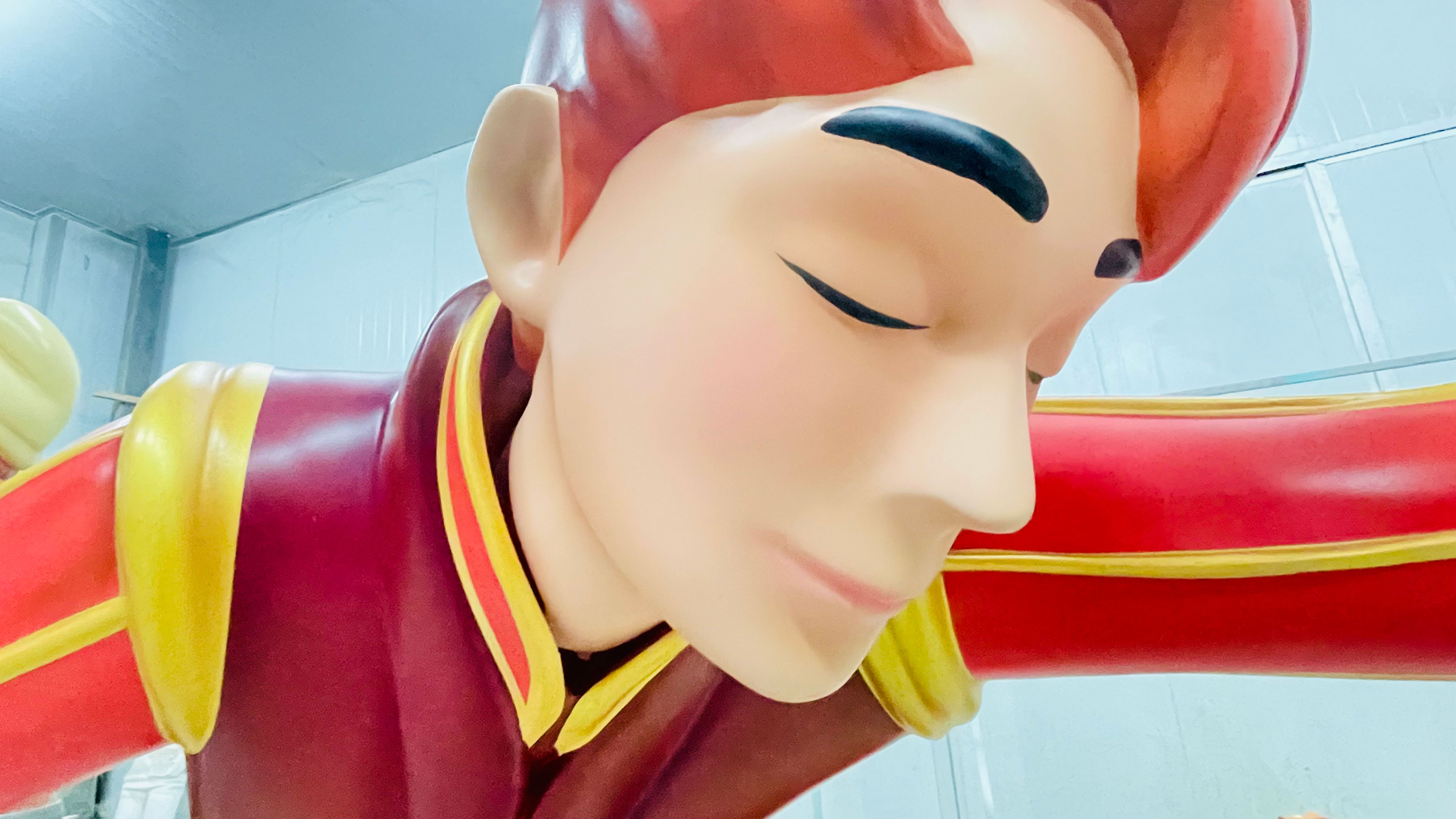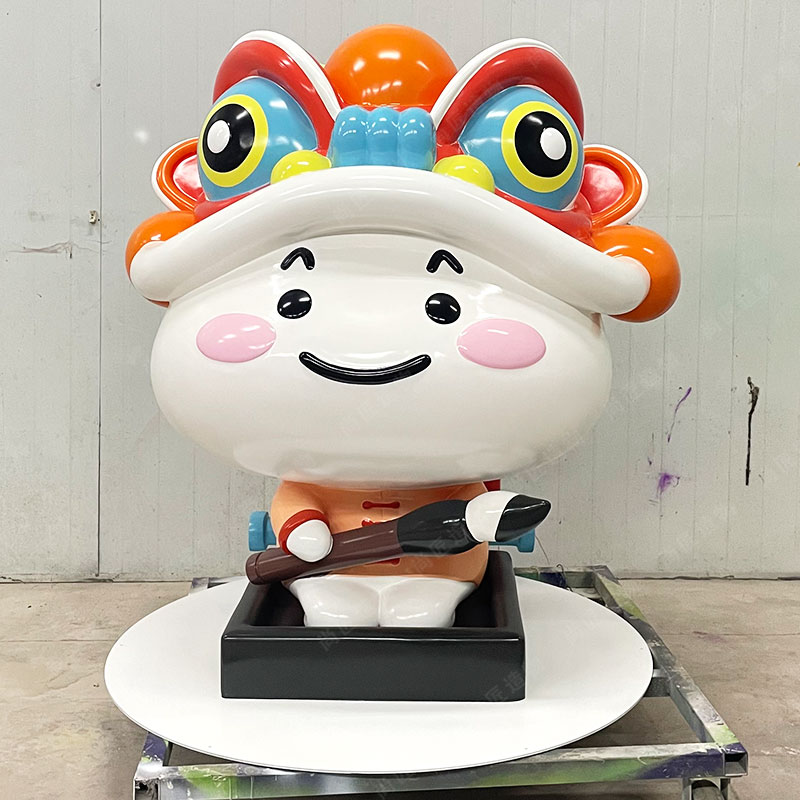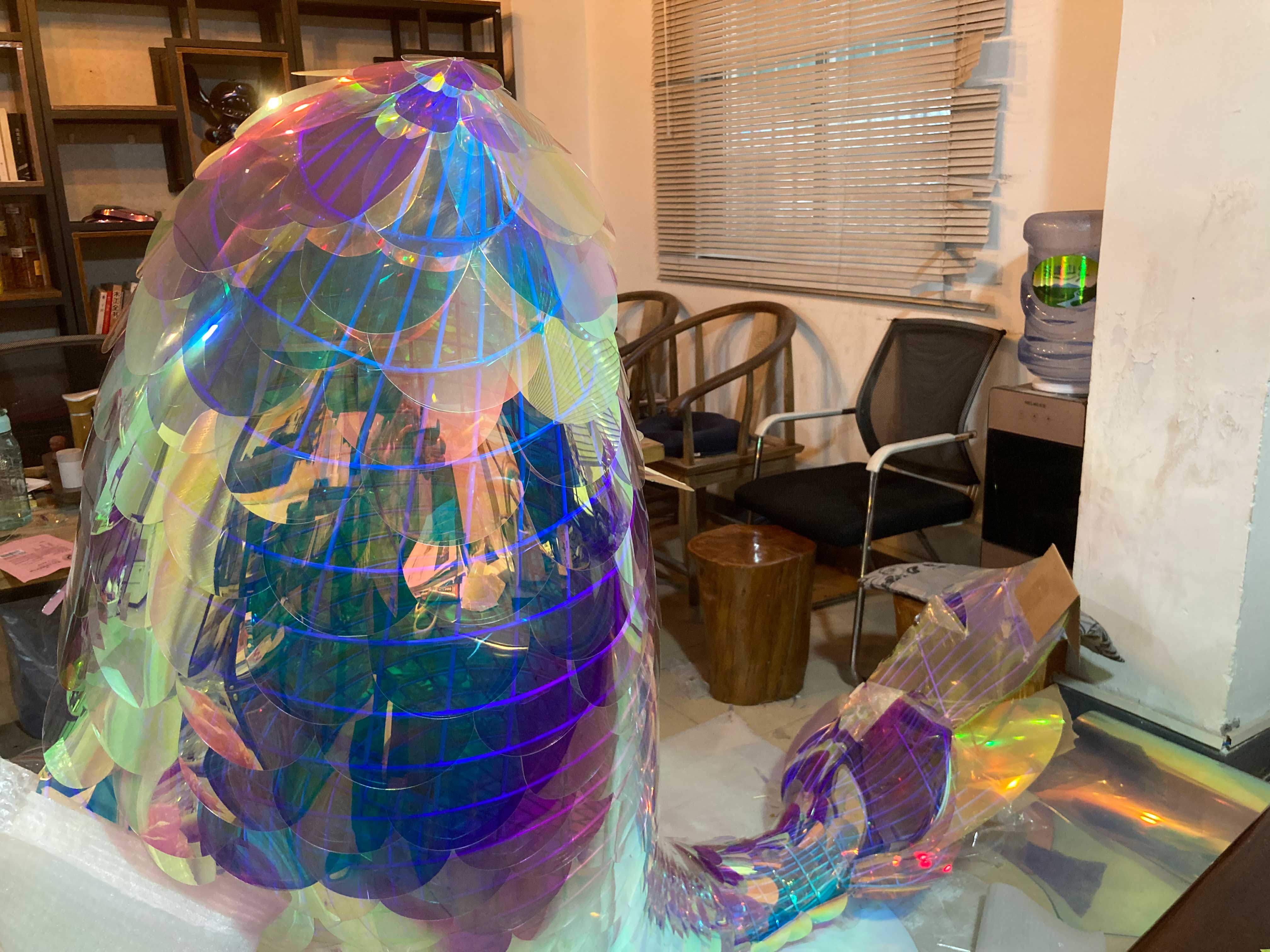Key Takeaways
Maintaining FRP sculptures requires a systematic approach to preserve their aesthetic and structural quality. Below are critical insights to guide effective care:
| Maintenance Aspect | Indoor Care | Outdoor Care |
|---|---|---|
| Cleaning Frequency | Monthly dusting | Bi-weekly washing |
| UV Protection | Minimal; indirect light | UV-resistant coatings |
| Seasonal Checks | Humidity control | Pre-winter sealing |
Regular cleaning with pH-neutral solutions prevents dirt buildup, while outdoor sculptures benefit from protective sealants to combat UV degradation. Inspect surfaces annually for micro-cracks, which can expand if untreated. Structural stability relies on securing anchor points, especially for large installations exposed to wind or temperature shifts. Indoor pieces need stable humidity levels (40–60%) to avoid resin warping.
For outdoor works, seasonal preparation is vital. Apply anti-fade coatings in spring and sealants before winter to prevent moisture infiltration. Minor scratches can be repaired with epoxy fillers, but deeper cracks may require professional restoration. Always prioritize gentle cleaning tools—abrasive materials risk damaging the gel coat.
By aligning care routines with environmental demands, FRP sculptures retain their visual appeal and durability for decades.

Essential Cleaning Techniques for FRP Sculptures
Regular cleaning is critical for preserving the appearance and longevity of fiber-reinforced polymer (FRP) sculptures. Begin by removing loose debris with a soft-bristle brush or microfiber cloth to prevent surface scratches. For general cleaning, mix mild dish soap with lukewarm water—avoid abrasive cleaners or solvents, which can degrade the resin coating.
Tip: Test any cleaning solution on a small, inconspicuous area first to ensure compatibility with the sculpture’s finish.
For stubborn stains like bird droppings or tree sap, apply a diluted vinegar solution (1:3 vinegar-to-water ratio) and let it sit for 2–3 minutes before gently scrubbing. Rinse thoroughly with clean water to prevent residue buildup, which can attract dirt over time. Pay special attention to textured surfaces or crevices where grime may accumulate, using a soft toothbrush for detailed areas.
Outdoor FRP pieces exposed to pollution or salt air may require monthly cleaning, while indoor sculptures typically need attention every 3–4 months. After washing, dry the surface with a lint-free cloth to minimize water spots. For realistic sculpture details, such as intricate facial features or delicate textures, opt for compressed air to dislodge dust without physical contact.
Conservator Insight: “Consistency matters more than intensity. Gentle, frequent cleaning outperforms aggressive methods that risk damaging the gel coat.”
By following these methods, you maintain both the aesthetic appeal and structural resilience of FRP artworks, aligning with broader maintenance strategies like UV protection and crack prevention.
UV Protection Strategies for Outdoor FRP Art
Outdoor FRP sculptures require proactive measures to combat UV radiation, which can degrade resin binders and cause fading over time. A primary defense is applying UV-resistant coatings, such as acrylic urethane or polyurethane finishes, which act as a barrier against sunlight. These coatings should be reapplied every 2-3 years, depending on climate intensity, to maintain effectiveness. For added protection, consider using wax-based polishes with UV inhibitors, which enhance gloss while reflecting harmful rays.
Positioning also plays a role: placing sculptures under shaded structures or using retractable awnings during peak sunlight hours reduces direct exposure. For installations in open areas, periodic rotation can help distribute UV impact evenly. Inspect surfaces annually for chalkiness or dullness—early signs of UV damage—and address them promptly with specialized cleaners and sealants.
Integrating these strategies with routine cleaning (https://en.artmovr.com/) experts. By combining preventive coatings, strategic placement, and consistent monitoring, the vibrancy and structural resilience of outdoor FRP art can endure for decades.

Preventing Cracks in Fiber-Reinforced Plastic Statues
Fiber-reinforced plastic (https://en.artmovr.com/) designs with intricate details, reinforce thin edges or protruding elements with additional resin layers during production or repairs.
Avoid placing FRP statues in high-traffic areas where accidental collisions are likely. Regularly inspect surfaces for hairline fractures, particularly near joints or load-bearing sections. If minor cracks appear, address them immediately using epoxy-based fillers matched to the sculpture’s color. For outdoor installations, apply UV-resistant coatings annually to prevent material brittleness, which accelerates cracking. Temperature fluctuations can cause FRP to expand and contract, so consider protective covers during extreme weather. By combining proactive design choices with consistent monitoring, most cracks can be prevented before they compromise structural integrity.

Maintaining Structural Integrity of FRP Installations
Structural integrity forms the backbone of FRP sculpture longevity, particularly for installations exposed to dynamic environments or heavy use. Regular inspections are critical—check for signs of stress concentration at joints, anchor points, or load-bearing sections. These areas may develop micro-cracks over time due to thermal expansion, vibrations, or uneven weight distribution. For freestanding sculptures, ensure bases remain level and secure, as shifting foundations can warp fiberglass layers.
Load capacity is another key consideration. While FRP is lightweight, installations supporting additional weight (https://en.artmovr.com/) components) require reinforced internal frameworks. Avoid exceeding manufacturer-recommended weight limits, and periodically test structural connections with gentle pressure. Environmental factors, such as freeze-thaw cycles or saltwater exposure, accelerate material fatigue; apply protective sealants to vulnerable edges and seams.
For large-scale or complex installations, consult engineering professionals to assess stress patterns using digital modeling tools. Proactive reinforcement—such as adding steel supports or epoxy-based fillers to high-stress zones—can prevent catastrophic failures. Addressing minor issues early ensures FRP sculptures retain their functional and aesthetic roles for decades.
Indoor vs Outdoor FRP Sculpture Care Guide
Proper maintenance of FRP sculptures requires tailored approaches depending on their installation environment. Indoor pieces generally face fewer environmental stressors but still need routine care. Dust accumulation, common in interior spaces, can dull surfaces over time. Use a soft microfiber cloth and mild soap solution for weekly cleaning, avoiding abrasive tools that might scratch the gel coat. Humidity control is critical—prolonged exposure to moisture in damp basements or bathrooms may weaken the resin matrix, so ensure adequate ventilation or use dehumidifiers.
Outdoor FRP sculptures, however, endure harsher conditions. UV radiation can fade colors and degrade the material, making UV-resistant coatings or automotive-grade wax essential for protection. Seasonal temperature fluctuations cause expansion and contraction, increasing crack risks. Inspect sculptures monthly for hairline fractures, especially near joints or load-bearing areas. Rinse outdoor installations with low-pressure water to remove pollutants like acid rain or bird droppings, which can corrode the surface. For areas prone to freeze-thaw cycles, consider winter covers to minimize water infiltration.
While stainless steel sculptures (https://en.artmovr.com/)) offer inherent weather resistance, FRP requires more proactive care. Transition smoothly between indoor and outdoor maintenance by adjusting routines seasonally—for example, increasing cleaning frequency for outdoor pieces during pollen-heavy spring months. Always prioritize gentle, non-chemical cleaning agents to preserve both aesthetics and structural integrity.
Expert Tips for Long-Lasting FRP Art Preservation
Preserving FRP sculptures requires a blend of proactive care and informed decision-making. Begin by establishing a routine inspection schedule, focusing on areas prone to stress, such as joints or thin sections. Use pH-neutral cleaners to avoid degrading the resin matrix, and always rinse thoroughly to prevent chemical residue buildup. For intricate designs, soft-bristle brushes or microfiber cloths help maintain surface details without abrasion.
When addressing UV exposure, consider applying automotive-grade ceramic coatings, which offer superior UV resistance compared to standard sealants. These coatings not only deflect harmful rays but also simplify future cleaning. For sculptures in high-traffic areas, periodic reinforcement with epoxy-based fillers can preempt structural weaknesses.
Environmental factors play a critical role—avoid placing outdoor pieces near sprinkler systems or acidic plants, as prolonged moisture and organic acids accelerate deterioration. Indoor installations benefit from humidity control (https://en.artmovr.com/), consult manufacturers about material-specific care, as pigmentation or texture additives may require tailored solutions.
Lastly, document maintenance activities and weather-related changes to identify patterns in wear. This data-driven approach enables timely interventions, extending the artwork’s lifespan while preserving its aesthetic intent.
Seasonal Maintenance Schedule for FRP Statues
FRP sculptures exposed to outdoor environments require tailored care throughout the year to address seasonal challenges. A structured maintenance schedule helps mitigate weather-related wear while preserving aesthetic and structural quality.
Spring: Begin with a thorough inspection after winter. Remove debris accumulated in crevices using soft brushes or low-pressure water. Check for micro-cracks or discoloration caused by freeze-thaw cycles. Apply a UV-resistant sealant before peak sunlight exposure to prevent fading.
Summer: Focus on heat and humidity management. Clean surfaces monthly with a mild detergent solution to remove pollen, dust, or bird droppings. Avoid abrasive tools that could scratch the gel coat. For sculptures in direct sunlight, consider temporary shading solutions during extreme heatwaves to minimize thermal expansion stress.
Fall: Prepare for colder months by clearing fallen leaves or organic matter, which can trap moisture and promote mold growth. Reinforce protective coatings, especially on edges and joints prone to cracking. Inspect drainage points to prevent water pooling during rains.
Winter: For regions with freezing temperatures, shield statues with breathable, waterproof covers to reduce ice damage. Avoid using salt-based deicers nearby, as chemicals can degrade the resin matrix. Indoor displays should be kept away from heating vents to prevent uneven drying.
Aligning care with seasonal shifts ensures proactive preservation, complementing broader strategies like UV protection and structural inspections outlined earlier. Adjust routines based on local climate patterns to optimize results.
Repairing Minor Damages in Fiberglass Resin Sculptures
Addressing minor damage in FRP sculptures promptly prevents small issues from escalating into structural problems. Begin by cleaning the affected area with mild soap and water to remove debris, then dry thoroughly. For superficial scratches or chips, lightly sand the damaged spot using 220-grit sandpaper until smooth, taking care not to erode surrounding layers.
If the damage exposes the fiberglass matting, apply a thin layer of epoxy resin mixed with a matching color pigment to seal the area. Use a putty knife to spread the resin evenly, feathering the edges to blend with the sculpture’s surface. Allow it to cure according to the product instructions—typically 24–48 hours—before sanding again with 400-grit paper for a seamless finish.
For hairline cracks, inject clear polyester resin into the fissure using a syringe, ensuring full penetration. Clamp the area temporarily if needed to maintain alignment during curing. Once hardened, sand and polish the repaired section to match the sculpture’s texture. Always wear gloves and a mask when handling resins to ensure safety. While DIY repairs work for minor flaws, consult a professional conservator for deeper cracks or complex damage to preserve the artwork’s integrity.
Conclusion
Proper maintenance of FRP sculptures ensures their aesthetic appeal and structural resilience over time. By following the guidelines outlined—from routine cleaning to UV protection and seasonal inspections—owners can significantly extend the lifespan of these artworks. As emphasized throughout this guide, proactive care tailored to indoor or outdoor environments is critical. Regular checks for cracks, discoloration, or surface wear allow for timely interventions, preventing minor issues from escalating into costly repairs.
While FRP is inherently durable, its longevity depends on consistent upkeep. Integrating a maintenance schedule aligned with seasonal changes, as discussed earlier, helps address environmental stressors like temperature fluctuations or moisture exposure. For outdoor installations, UV-resistant coatings and strategic placement remain vital defenses against sun damage. Indoors, controlling dust and humidity levels preserves surface finishes.
Ultimately, the effort invested in maintaining FRP sculptures reflects their value as lasting artistic or functional pieces. By combining practical techniques with expert insights, caretakers can ensure these works remain vibrant and intact for years to come. Remember that even small, consistent actions—like gentle cleaning or prompt repairs—contribute to preserving the sculpture’s integrity and beauty.
Frequently Asked Questions
How often should outdoor FRP sculptures be cleaned?
Outdoor installations benefit from bi-monthly cleaning during mild weather. Increase frequency to monthly in coastal or high-pollution areas to prevent salt or grime buildup.
Can household cleaners damage FRP surfaces?
Avoid acidic or abrasive products like bleach or scouring pads. Use pH-neutral soap diluted in warm water, followed by thorough rinsing to prevent residue accumulation.
What distinguishes indoor and outdoor FRP maintenance?
Outdoor pieces require UV-resistant coatings and drainage checks, while indoor sculptures need dust management and humidity control below 60% to prevent fiber swelling.
Is cracking always a structural concern?
Surface-level micro-cracks under 1mm often result from thermal expansion and can be filled with epoxy putty. Deep cracks penetrating the fiber layers warrant professional assessment.
How does temperature affect FRP longevity?
Prolonged exposure below -20°F (-29°C) may cause brittleness, while temperatures above 120°F (49°C) risk resin softening. Use protective covers during extreme weather events.
Are automotive products safe for FRP protection?
Non-yellowing automotive clear coats provide effective UV shielding. Always test products on inconspicuous areas first—some silicones or acrylics may alter surface textures.
 ch
ch English
English






